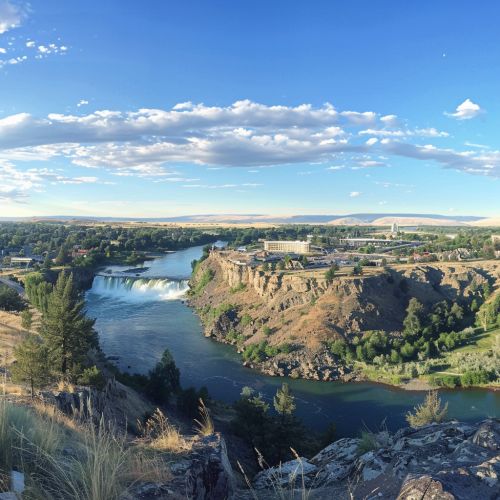Idaho Falls
History
Idaho Falls is a city in and the county seat of Bonneville County, in the eastern part of the U.S. state of Idaho. It is the state's largest city outside the Boise metropolitan area. As of the 2010 census, the population of Idaho Falls was 56,813, with a metro population of 136,108. As of 2018, the population was estimated at 61,535.
The area around Idaho Falls was first sparsely settled by cattle and sheep ranchers. No significant development took place until 1864, when a man named Harry Rickets built and operated a ferry on the Snake River. The ferry served a new tide of westward migration and travel on the Montana Trail following the Bear River Massacre of Shoshone Indians in 1863. The present-day site of Idaho Falls became a permanent settlement when freighter Matt Taylor built a timber-frame toll bridge across a narrow black basaltic gorge of the river 7 miles (11 km) downstream from the ferry. The bridge improved travel for settlers moving north and west, and for miners, freighters, and others seeking riches in the gold fields of Idaho and Montana—especially the boom towns of Bannack and Virginia City.


Geography
Idaho Falls is located at 43°30′N 112°1′W, at an elevation of 4,744 feet (1,446 m) above sea level. According to the United States Census Bureau, the city has a total area of 22.80 square miles (59.05 km2), of which, 22.35 square miles (57.89 km2) is land and 0.45 square miles (1.17 km2) is water.
The Snake River flows through the city and forms the falls for which the city is named. There are several bridges over the Snake River in the city area, including the I-15 bridge, the Broadway Bridge, and the Taylor Toll Bridge.
Climate
Idaho Falls experiences a semi-arid climate (Köppen BSk), with winters that are moderately long and cold, and summers that are warm and dry. The city's weather is heavily influenced by the Snake River and the surrounding mountains. The city's location near the high mountains of central Idaho brings nightly low temperatures that are somewhat cooler than would otherwise be expected.
Economy
Idaho Falls serves as a hub to all of eastern Idaho and much of western Wyoming. The economies of these areas are intertwined with the city through a network of available goods and services, employment, and commerce. Some of the main sectors of the Idaho Falls economy include healthcare, agriculture, construction, travel and tourism, and professional services.
In addition to private industry, Idaho Falls is home to several government entities, including the Idaho National Laboratory, which is one of the largest employers in the area. The laboratory performs work in each of the strategic goal areas of the Department of Energy: energy, national security, science, and environment.
Demographics
As of the census of 2010, there were 56,813 people, 21,203 households, and 14,510 families residing in the city. The population density was 2,542.0 inhabitants per square mile (981.5/km2). There were 22,977 housing units at an average density of 1,028.9 per square mile (397.3/km2). The racial makeup of the city was 89.1% White, 0.4% African American, 0.6% Native American, 1.2% Asian, 0.2% Pacific Islander, 6.1% from other races, and 2.3% from two or more races. Hispanic or Latino of any race were 12.8% of the population.
Education
Idaho Falls is served by two public school districts and several private schools. The two public school districts are: Idaho Falls School District 91 and Bonneville Joint School District 93. The city is home to 18 elementary schools, 4 middle schools, and 4 high schools.
In addition to the public education system, Idaho Falls has several private schools, including the Holy Rosary Catholic School and the Watersprings School. The city is also home to a number of higher education institutions, including the College of Eastern Idaho and a campus of the University of Idaho.
Culture
Idaho Falls has a vibrant arts community. The Willard Arts Center, located downtown, houses the Colonial Theater, the Idaho Falls Arts Council Gallery, and the Artitorium on Broadway. The city also hosts the Idaho Falls Symphony, the Idaho Falls Opera Theatre, and the Ballet Idaho Falls.
The city is also home to several museums and historic sites. The Museum of Idaho showcases local artifacts and history, and hosts traveling exhibits. The Idaho Falls Historic Downtown is a hub for shopping, dining, and entertainment.
